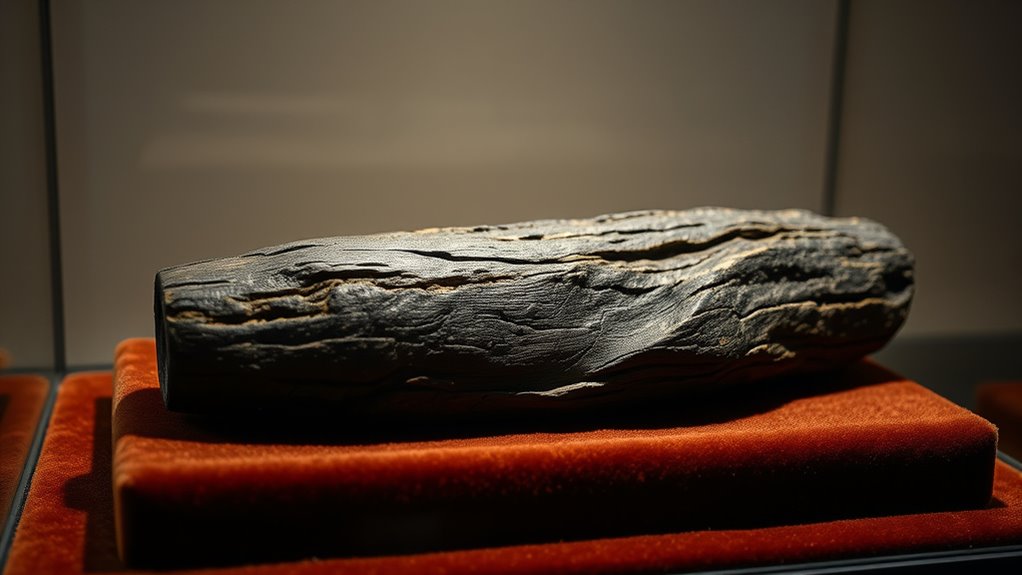Did you know the world’s oldest wooden artifact is about 476,000 years old? Discovered near Kalambo Falls in Africa, this ancient structure shows early humans mastered complex wood use long before Homo sapiens appeared. Preserved in waterlogged conditions, it reveals how our ancestors built platforms or shelters. If you’re curious, you’ll learn more about how this discovery reshapes our understanding of early human innovation and resourcefulness.
Key Takeaways
- The oldest known wooden artifact is a structure near Kalambo Falls, Zambia/Tanzania, dating approximately 476,000 years old.
- It consists of two interlocking logs joined by a notch, showcasing early woodworking skills.
- Preservation was possible due to waterlogged conditions, enabling precise luminescence dating.
- This discovery indicates early hominins used wood for construction well before Homo sapiens.
- It extends the history of wooden craftsmanship by nearly 500,000 years, highlighting complex early human behaviors.

Did you know that the world’s oldest known wooden structure dates back nearly half a million years? It was discovered near Kalambo Falls, on the border of Zambia and Tanzania, close to Lake Tanganyika. This ancient find challenges what we thought about early hominin capabilities.
The structure consists of two interlocking logs joined by a notch, shaped with stone tools. Its preservation is extraordinary—high water levels and fine sediment encasing the wood kept it intact for thousands of years. This preservation allowed scientists to confirm its age through luminescence dating at approximately 476,000 years old.
This ancient wooden structure probably served as a platform, walkway, storage site for food or firewood, or perhaps a shelter base. The discovery suggests that early humans, likely Homo heidelbergensis or even earlier hominins, possessed a level of cognitive and technical skill previously unrecognized for that period. The site’s waterlogged conditions contributed significantly to the preservation of the wooden artifacts, making this discovery possible.
Understanding early hominin innovation helps us appreciate the diversity of their adaptive strategies. The site where it was found also yielded Acheulean stone tools, which were used by early hominins for cutting and processing materials.
These tools, along with the wooden artifacts, offer a glimpse into the complex behaviors of our ancestors, long before Homo sapiens appeared. Previously, evidence of early hominin use of wood was limited to older, less definitive artifacts from the 1950s and 1960s, which lacked clear dating and context.
Early hominin wood use predates Homo sapiens, revealing complex behaviors long before modern humans appeared.
This new discovery pushes back the timeline of wooden construction by almost 500,000 years, showing that early humans were experimenting with and utilizing wood in ways we hadn’t fully appreciated. The significance of this find extends beyond its age.
It challenges the assumption that advanced woodworking was exclusive to modern humans or later hominins. Instead, it suggests that a broad range of hominin species had the cognitive capacity for complex tasks like building structures and manipulating wood.
This discovery also broadens our understanding of Acheulean culture, which was previously thought to focus mainly on stone tools. Now, we see that early humans integrated wood into their daily lives, possibly for shelter or resource management. Understanding early hominin innovation helps us appreciate the diversity of their adaptive strategies.
Other ancient wooden artifacts, such as a polished plank over 780,000 years old found in Israel or the Shigir Idol from Russia, demonstrate that humans have long used wood for various purposes—from functional construction to artistic expression.
These finds, combined with the Kalambo structure, reveal a long tradition of woodworking, highlighting the importance of environmental conditions—like water saturation or peat bogs—in preserving organic materials so archaeologists can study them.
This rare glimpse into early hominin life shows that our ancestors were more advanced and resourceful than we once believed.
Conclusion
So, next time you see an old wooden piece, remember it’s a tiny window into our past. This artifact proves that age is just a number, and history’s treasures can surprise us. Like they say, “Old is gold”—and in this case, it’s also wood. Cherish these ancient remnants; they remind us that even the simplest things can hold extraordinary stories. Keep exploring, and you’ll always find something worth marveling at.









